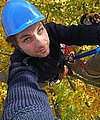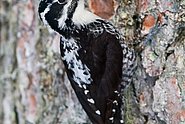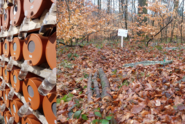
Deadwood ¶
Deadwood is of major importance for biodiversity in forests: about one fifth of forest organisms use deadwood as a habitat and food source. But the population of numerous deadwood species is declining.
Contents ¶

Roughly 6,000 species of insects, fungi, vertebrates and plants in Switzerland depend on old trees and deadwood. Breeding birds find nesting opportunities in the cavities of old tree trunks, and specialized insect larvae can develop in the mulm of these cavities. This ensures birds and other insectivores have filled pantries, and the nutrients present in the wood are a food source for fungi.
To maintain this biodiversity, the resource deadwood must be present in sufficient quantity over long periods of time. In the former primeval forests, 20-50% of the trees were old or dead at any given time. Today, however, there is often too little of it in managed forests.
Although the amount of deadwood in the forest has been increasing again since the middle of the 20th century, many species that depend on deadwood (=xylobionts) are endangered.
Reasons for the decline of deadwood species ¶
- the exploitation of trees before they reach their old age and, consequently, the absence of old habitat trees,
- the disappearance of ancient trees in semi-open wooded pastures and traditional "selvas" (areas of pasture, individual trees and small patches of forest that are part of the forest,
- the often still systematic clearing of "damaged wood" after storms or forest fires,
- the absence of large-dimension deadwood in advanced stages of decay,
- the increasing use of low-quality, small-diameter wood as energy wood.
However, providing enough deadwood alone is not always enough. Many longhorned beetles and jewel beetles develop in deadwood but, as adults, depend on flower pollen for food.
Contact ¶
Projects ¶
Publications ¶
Bütler R., Gossner M., Lachat T., Abegg M., Lauper B. (2025) Deadwood. In A. Strauss & C. Fischer (Eds.), Forest Report 2025. Development, condition and use of Swiss forests. Bern; Birmensdorf: Federal Office for the Environment FOEN; Swiss Federal Institute for Forest, Snow and Landscape Research WSL. 84-85. Institutional Repository DORA
Bütler R., Gossner M., Lachat T., Abegg M., Lauper B. (2025) Totholz. In A. Strauss & C. Fischer (Eds.), Waldbericht 2025. Entwicklung, Zustand und Nutzung des Schweizer Waldes. Bern; Birmensdorf: Bundesamt für Umwelt BAFU; Eidg. Forschungsanstalt für Wald Schnee und Landschaft WSL. 84-85. Institutional Repository DORA
Kaennel Dobbertin M., Bütler R. (2024) Totholz und Habitatbäume. In Eidg. Forschungsanstalt WSL (Ed.), Poesie des Vergehens. Vom vielfältigen Leben in einer toten Fichte. Bern: Haupt Verlag. 184-185. Institutional Repository DORA
Basile M., Parisi F., Tognetti R., Francini S., Lombardi F., Marchetti M., … Chirici G. (2023) Diversity of beetle species and functional traits along gradients of deadwood suggests weak environmental filtering. For. Ecosyst. 10, 100090 (8 pp.). doi:10.1016/j.fecs.2023.100090 Institutional Repository DORA
Bütler R., Bolliger M. (2023) Totholz alles andere als tot!. Natura Helv. 52(Dez-Jan), 20-25. Institutional Repository DORA





